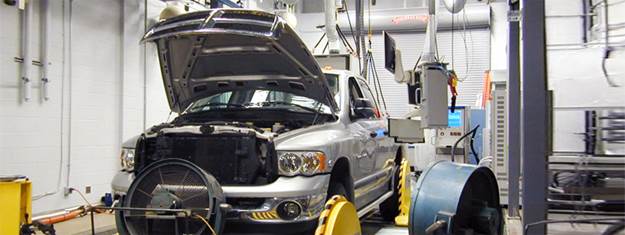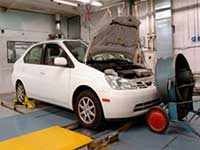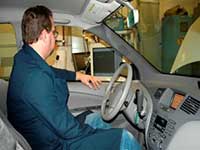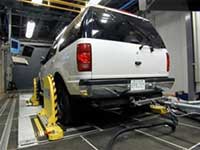How Much Money Does The Epa Get To Test Vehicle Emissions
Testing at the National Vehicle and Fuel Emissions Laboratory

EPA's National Vehicle and Fuel Emissions Laboratory (NVFEL) tests new cars and trucks sold in the U.S. to ensure that they comply with federal emissions and fuel economic system standards.
Certification Emission Testing
All new cars and trucks sold in the U.S. must be certified to run into federal emission standards, such every bit limits on the amount of smog-forming and greenhouse gas emissions that they can produce. Virtually testing is performed by machine manufacturers at their own facilities. EPA and so audits the data and performs its own testing on some of the vehicles to confirm the manufacturers' results.
Fuel Economy Testing
EPA is also responsible for providing fuel economy data for the fuel economy label (or window sticker) that you see on all new cars and lite trucks. Automakers are required to follow very specific test procedures and submit the fuel economy information to EPA for all their models each twelvemonth. In general, vehicles are tested over five defined exam cycles that were created to represent typical driving weather condition in the U.S.:
- City test - no heating, ventilation, and air conditioning (HVAC) functioning
- Highway test - no HVAC functioning
- More than aggressive/high speed test - no HVAC performance
- Hot test at 95° F - HVAC set to absurd the cabin
- Cold exam at 20° F - HVAC set to specific settings for estrus and defrost
The results of these tests are then combined and weighted to judge average use, which results in official MPG values.
Range Testing for Electric Vehicles
An all-electric vehicle (EV) produces no smog-forming or greenhouse gas emissions from its tailpipe. For EVs, vehicle testing provides important label information, such every bit fuel economic system and range.
For EV range testing:
- A vehicle with a fully charged battery is driven continuously over the EPA metropolis cycle until the battery is depleted and the vehicle can drive no further. The distance driven is recorded. This is repeated, again starting with a full charge, over the EPA highway bicycle, again recording the altitude driven when the battery is depleted. This "single cycle" test consists of multiple repeat drives of the city or highway cycle.
- Automakers as well accept the option of doing a multi-wheel examination, which consists of four urban center cycles, two highway cycles, and two constant speed cycles.*
- All testing is done in a laboratory on a dynamometer.
- The city and highway driving ranges determined from this testing are adjusted to account for real-world factors that are non represented on the laboratory exam procedures. These factors include such things the impact of air conditioning, of cold temperatures, and of high speed and aggressive driving beliefs. Although the regulations permit some optional approaches, the most common approach is to use a factor of 0.7 to conform all the test parameters, including range. For instance:
- An EV achieves 200 miles on the highway laboratory examination. Real-world highway driving range → 200 10 0.7 = 140 miles to business relationship for ambitious driving and HVAC use.
- The adjusted city and highway range values are weighted together by 55% and 45%, respectively, to determine the combined metropolis and highway driving range that appears on the EPA fuel economy characterization. For case:
- Presume an adjusted city range of 168 miles and an adapted highway range of 140 (from example above). The official combined range value → (0.55 x 168) + (0.45 x 140) = 155 miles (values are rounded to the nearest whole number).
Specific details on testing can exist found in EPA regulations at 40 CFR 600.116-12 - Special procedures related to electrical vehicles and hybrid electrical vehicles. For more information on the other acceptable ("optional") approaches, visit xl CFR 600.210-12 Calculation of fuel economic system and CO2 emission values for labeling.
The Lab Testing Procedure
Data is derived from vehicle testing washed at EPA's NVFEL facility and by vehicle manufacturers who submit their test information to EPA for verification. More information about how vehicles are tested and test procedure schedules.



* Some of these methods volition differ for alternative-fueled vehicles, such every bit electric vehicles.
*The sequence consists of city bicycle, highway wheel, city bike, mid-test constant speed cycle, city bicycle, highway bicycle, metropolis bike, and end-of-examination constant speed cycle.
Source: https://www.epa.gov/greenvehicles/testing-national-vehicle-and-fuel-emissions-laboratory
Posted by: ridingerfirwass.blogspot.com

0 Response to "How Much Money Does The Epa Get To Test Vehicle Emissions"
Post a Comment